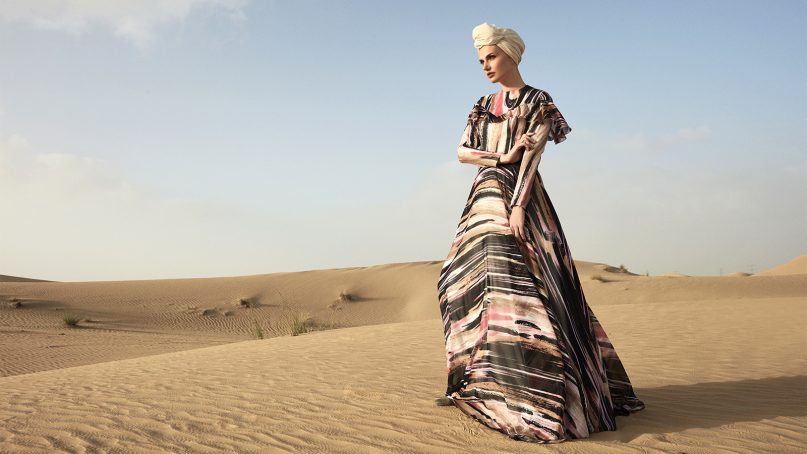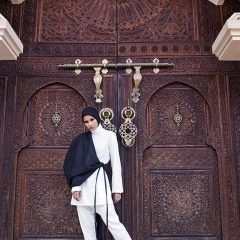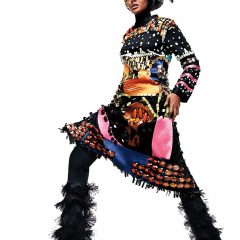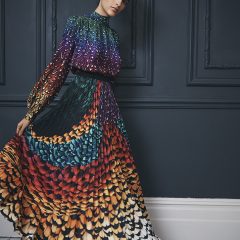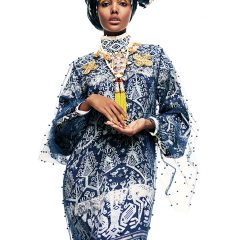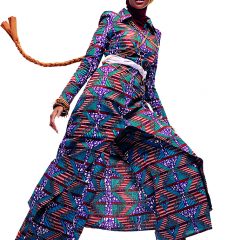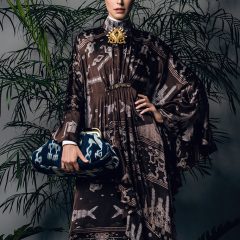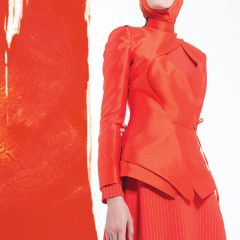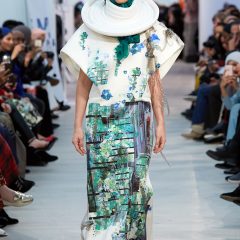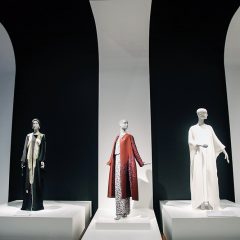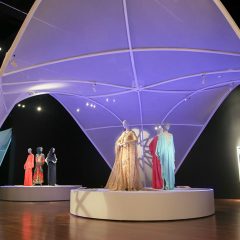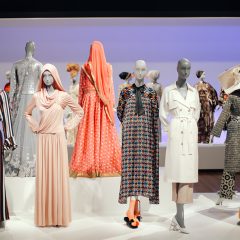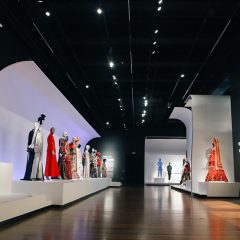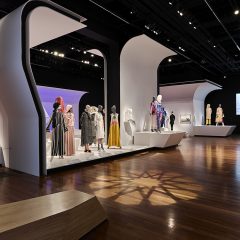(RNS) – It’s a good time to be a Muslim in the world of fashion design.
At New York Fashion Week in September, designer Eman Idil Bare premiered her crowdfunded debut collection. Days later, British blogger Dina Torkia released her book “Modestly,” detailing her journey to becoming an international modest fashion icon.
Meanwhile, Texas-based designer Subhi Taha is gearing up to launch the follow-up to his sold-out 2016 line of unisex modest wear. And major retailers Uniqlo and Macy’s have partnered with Muslim designers Hana Tajima and Lisa Vogl, respectively, to produce modest clothing lines for mainstream audiences.
And yes, Project Runway fans, last season Ayana Ife became the show’s first modest fashion designer – and first Muslim designer – to reach the season finale.
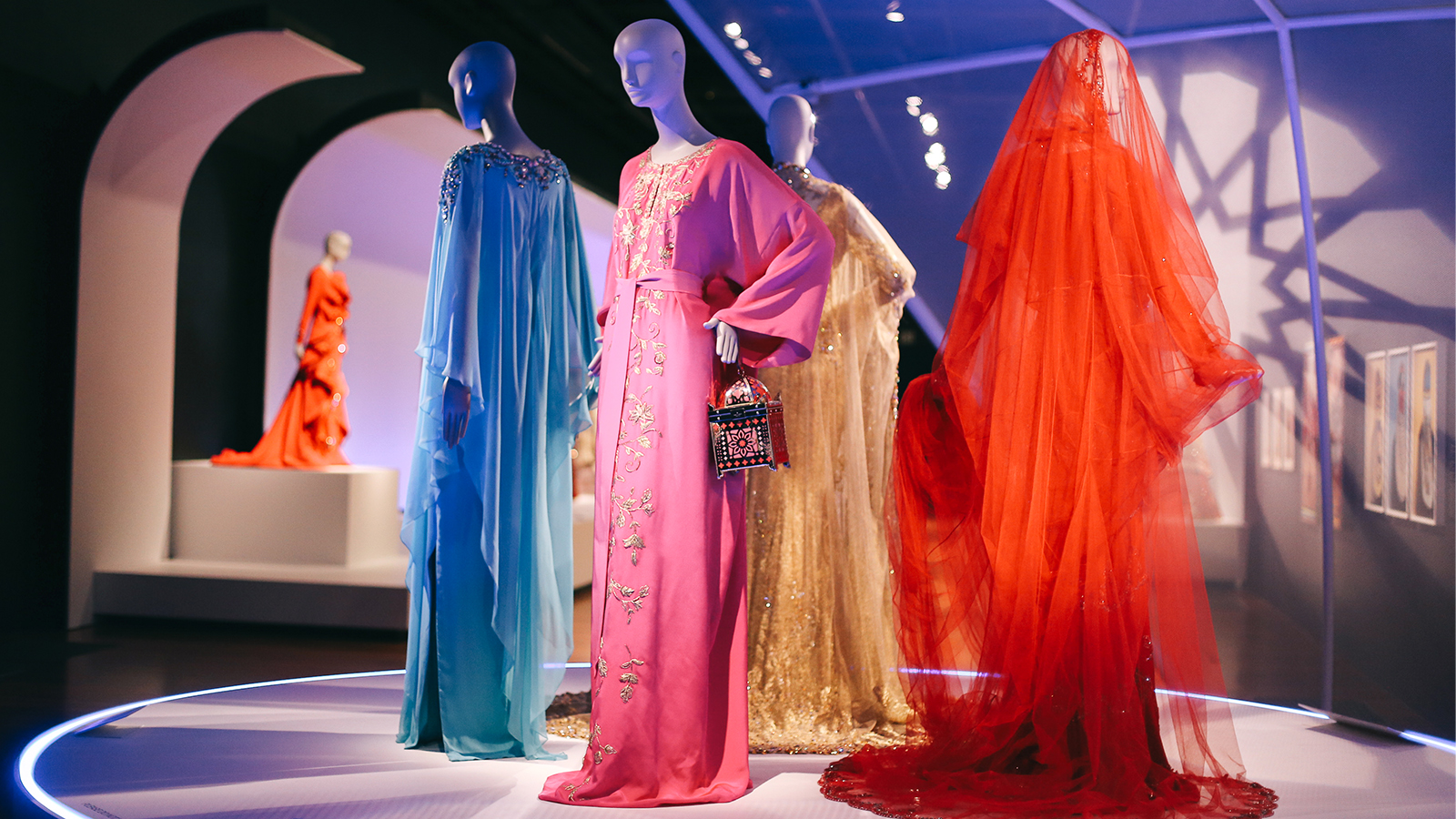
Selections on display in the de Young Museum’s “Contemporary Muslim Fashions” installation in San Francisco. Photo courtesy of Fine Arts Museums of San Francisco
Now, the de Young Museum in San Francisco has produced “Contemporary Muslim Fashions,” the first major museum exhibition to focus on Islamic fashion worldwide.
The broad consideration of Muslim clothing design is long overdue, say the show’s curators and its supporters at the de Young. It is the first and only major show developed under the museum’s former director Max Hollein, who called it a “much-needed exploration of a multifaceted topic as yet largely unexplored by museums.”
“This exhibition stands out in our long history of outstanding fashion exhibitions and will shed light onto larger political, social and cultural understandings and misunderstandings,” he said.
The exhibition, which opened Sept. 22 and runs until January 2019, helps to correct a long history of misinformed, even racist attitudes towards the hijab, burqa and Muslim women as a whole.
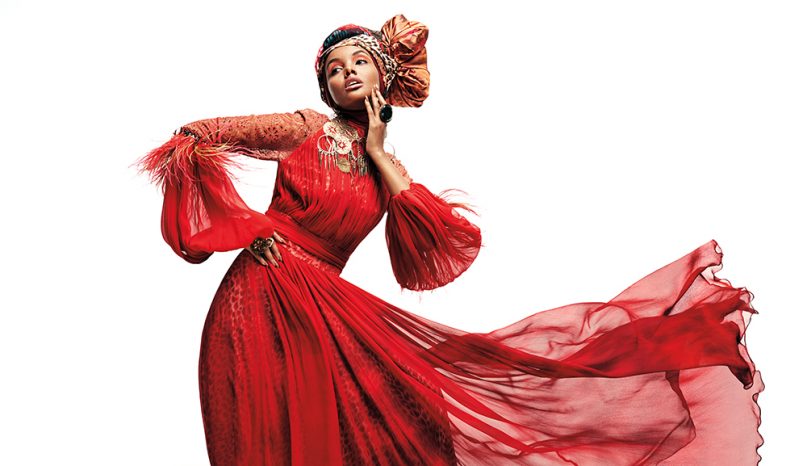
Designer Melinda Looi (b. 1973, Malaysia) for Melinda Looi (est. 2012, Malaysia) featuring turban, earrings and rings, tie-dyed effect long dress with gathers on front body. A selection from the de Young Museum’s “Contemporary Muslim Fashions” installation in San Francisco. Photo by Sebastian Kim/Fine Arts Museums of San Francisco
- Photography by Langston Hues (American, b.1988), Untitled, Putra Jaya, Malaysia, 2013 – 2015. A selection from the de Young Museum’s “Contemporary Muslim Fashions” installation in San Francisco. Photo courtesy of Fine Arts Museums of San Francisco
- Dian Pelangi (b. 1991, Indonesia). Ensemble (tunic, pants, inner headscarf, and scarves). Co-Identity Collection, Jakarta Fashion Week 2016. Cotton denim with beading and embroidery, complex weave with fringe appliqué, spandex knit with beading, wax-resist dyed (batik) Thai silk. A selection from the de Young Museum’s “Contemporary Muslim Fashions” installation in San Francisco. Photo by Sebastian Kim/Fine Arts Museums of San Francisco
- MARY KATRANTZOU skirt and shirt, MALONE SOULIERS shoes, December 2017 Silk, polyester. A selection from the de Young Museum’s “Contemporary Muslim Fashions” installation in San Francisco. Photo by Brian Daly/Fine Arts Museums of San Francisco
- Itang Yunasz (b. Jakarta, 1958) for Itang Yunasz (Indonesian, est. 1986) Ensemble (abaya, wrap, and hijab), Tribalux Collection, Spring/Summer 2018 Silk satin, tulle, antique cotton warp-faced plain weave with warp-resist dyeing (Sumba ikat) Jewelry by MannaQueen for Itang Yunasz, 2018. A selection from the de Young Museum’s “Contemporary Muslim Fashions” installation in San Francisco. Photo by Sebastian Kim/Fine Arts Museums of San Francisco
- Naima Muhammad (b. 1973, United States) for House of Coqueta (est. 2010, United States) Ensemble (tunic, pants and head wrap), Yar Hawwa Collection, 2017. Printed Ghanaian cotton. A selection from the de Young Museum’s “Contemporary Muslim Fashions” installation in San Francisco. Photo by Sebastian Kim/Fine Arts Museums of San Francisco
- Itang Yunasz (b. Jakarta, 1958) for Itang Yunasz (Indonesian, est. 1986). Ensemble (caftan, top, scarf, legging boot, and jewelry) 2018, Silk satin, silk chiffon, and spandex. Jewelry by MannaQueen for Itang Yunasz, 2018. A selection from the de Young Museum’s “Contemporary Muslim Fashions” installation in San Francisco. Photo courtesy of Fine Arts Museums of San Francisco
- HASLINDA RAHIM (b. 1971, Malaysia) for BLANCHEUR (est. 2014, Malaysia). “Into the Shadows” ensemble (half-vest, jacket, shirtdress, and hijab), Spring/Summer 2016. Cotton with silk finishing, neoprene. A selection from the de Young Museum’s “Contemporary Muslim Fashions” installation in San Francisco. Photo courtesy of Fine Arts Museums of San Francisco
- Rebecca Kellett (b. United Kingdom, 1993) for Rebecca Kellett (est. London, 2015), Ensemble: Dress, Belt, Headscarf, Neckpiece, Sunglasses, and Boots, Autumn/Winter 2017, digital printed satin, synthetic net, plastic sequins, PVC, plastic, and acrylic yarn; silk plain weave; synthetic polymer (polystyrene); acetate, Swarovski crystals, and 24-karat gold; and leather. Neckpiece designed by Della Reed, sunglasses designed by Anna-Karin Karlsson, and boots by Dr. Martens. A selection from the de Young Museum’s “Contemporary Muslim Fashions” installation in San Francisco. Photo courtesy of Fine Arts Museums of San Francisco
“Muslim women and the Muslim dress code have been bashed around and criticized by a lot of people here in the U.S. and around the world,” said Shereen Sabet, whose Southern California-based modest swimwear company Splashgear is one of 45 labels and retailers featured in the exhibition. “It’s been 12 years since I started this work, and I still remember all the negativity I heard from everyday people and from pundits every day.”
For an institution with the cultural heft of the de Young to recognize Muslim designers’ decades of creativity and effort shows “courage and enlightenment,” Sabet told Religion News Service. “I just hope this signals a change in the everyday conversation regarding modesty and how it intersects with high-culture fashion.”
Laura L. Camerlengo, associate curator of costume and textiles at the Fine Arts Museums of San Francisco, was careful to point out that the show was planned long before President Trump, whose administration civil rights advocates have decried as anti-Muslim, took office.
“We’ve been working on this exhibition for years but it’s just become more and more and more relevant as we continued,” Camerlengo told RNS.
But those who come just for the politics will find themselves surprised and enchanted by the artistry of the clothes shown.
“Sometimes, particularly in our news media, we have a perception of Muslim women being covered in dark swaths of fabric,” said Camerlengo. “In fact, modest fashion worn by Muslim women is highly diverse and influenced by both global fashion trends and local cultures and styles.”
The de Young, which has no Muslim curators on staff, collaborated with about 75 members of local Muslim communities to come up with a diverse collection of clothing chosen from various styles and regions as they selected pieces.
- The de Young Museum’s “Contemporary Muslim Fashions” installation in San Francisco. Photo courtesy of Fine Arts Museums of San Francisco
- The de Young Museum’s “Contemporary Muslim Fashions” installation in San Francisco. Photo courtesy of Fine Arts Museums of San Francisco
- The de Young Museum’s “Contemporary Muslim Fashions” installation in San Francisco. Photo courtesy of Fine Arts Museums of San Francisco
- The de Young Museum’s “Contemporary Muslim Fashions” installation in San Francisco. Photo by Randy Dodson/Fine Arts Museums of San Francisco
- The de Young Museum’s “Contemporary Muslim Fashions” installation in San Francisco. Photo by Randy Dodson/Fine Arts Museums of San Francisco
Face-covering niqabs and burqas are not in much evidence in the show. Rather, the curators highlight colorful designer dresses and caftans from around the Middle East and Southeast Asia.
The best of the show also includes a Slow Factory bomber jacket inscribed with the Declaration of Independence, Nike’s high-performance athletic Pro Hijab, and an embroidered navy two-piece bathing suit worn by hijab-wearing model Halima Aden for her headline-grabbing performance at the Miss Minnesota USA pageant’s swimsuit competition in 2016. Such selections, the curators say, offer just a taste of the many unexpected forms Islamic apparel can take.
The show also highlights social media’s role in bringing Islamic fashions to the forefront. In the early 2000s, young Muslim designers and fashionistas began turning to Facebook, blogging platforms, YouTube and Instagram to share their own perspectives when they felt unrepresented – or misrepresented – in mainstream media.
De Young’s team traveled to New York City and several Southeast Asian and Middle Eastern nations to meet designers on the ground. But using social media, Camerlengo said, allowed the team to traverse remote corners of the world for their show.
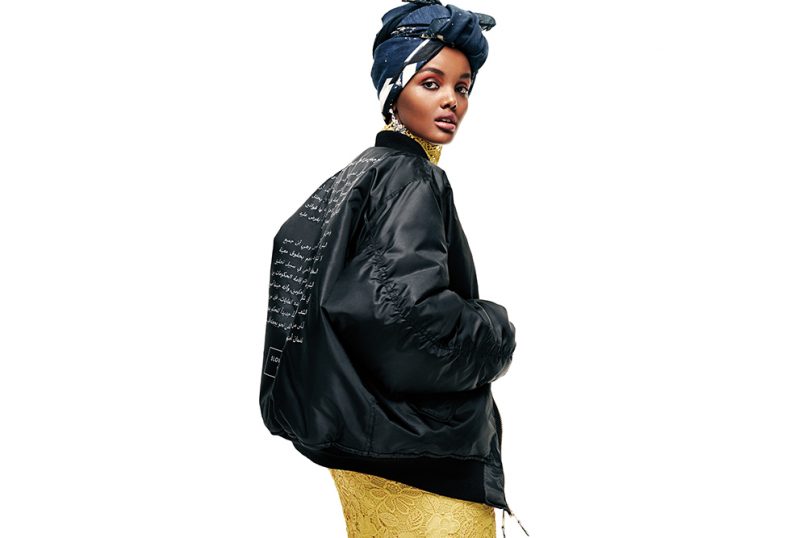
Designer Céline Semaan Vernon (b. 1982, Lebanon) for Slow Factory (est. 2012, United States) “US Constitution and First Amendment” flight jacket and “Banned” scarf (worn as turban), 2017. Photo by Sebastian Kim/Fine Arts Museums of San Francisco
“What we see now in the current generation of bloggers and social media influencers is that they’re using fashion as a means to address social and political issues,” said Camerlengo.
The exhibition also features a live feed of Instagram posts from bloggers like Fatima Abdallah, Hoda Katebi and Leah Vernon, all of whom are working to address bigger religious, social and political concerns with their fashion. Her team hopes the show can similarly use fashion to tap into broader conversations about society and culture; the museum even set up a special public discussion group on Facebook to make the exhibition accessible to Muslims around the world and take the conversation beyond the gallery walls.
Sabet, who focuses on modest athletic wear, said she appreciates de Young’s attention to the Muslim fashion industries that have been around for decades before bloggers and influencers brought the topic to the limelight.
“It isn’t something that happened overnight,” Sabet told RNS. “There’s been an established history of modest fashion broadly and Muslim haute couture in particular. It’s just taken this long to percolate, or at least for someone to notice it in the mainstream. ”
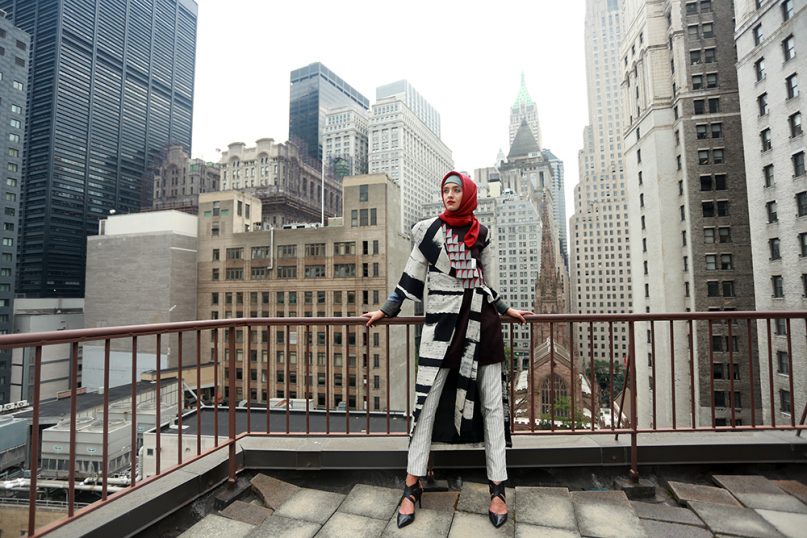
Designer Dian Pelangi (Indonesian, b. 1991) for New York Fashion Week, 2017. Ensemble: Cap, Headscarf, Top, Jacket, Skirt and Pants, 2017, Thai silk, batik Thai silk with songket (supplementary-weft patterning), striped silk (Tenun Salur), wood beaded appliqué. A selection from the de Young Museum’s “Contemporary Muslim Fashions” installation in San Francisco. Photo courtesy of Fine Arts Museums of San Francisco
